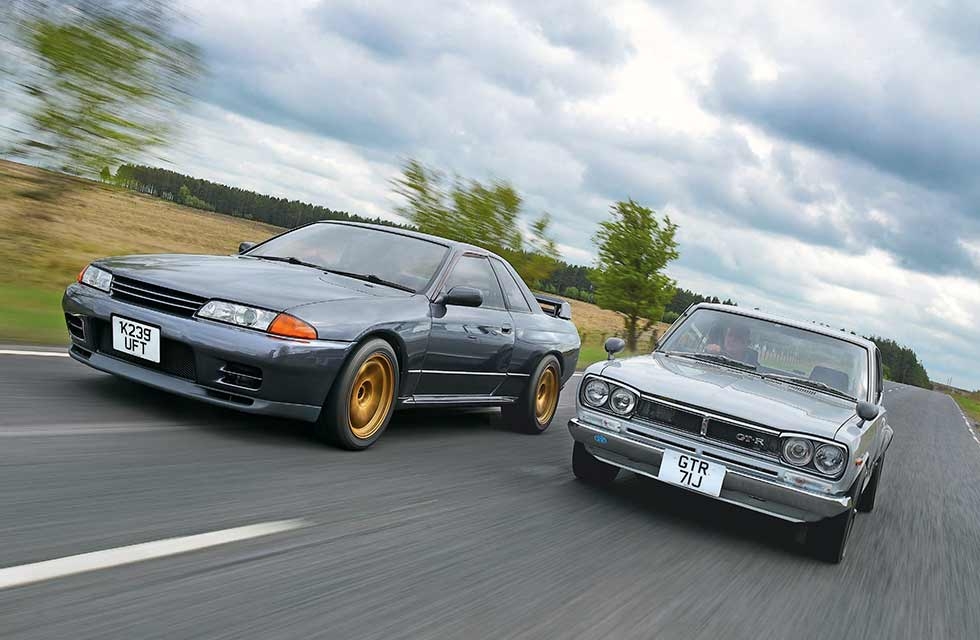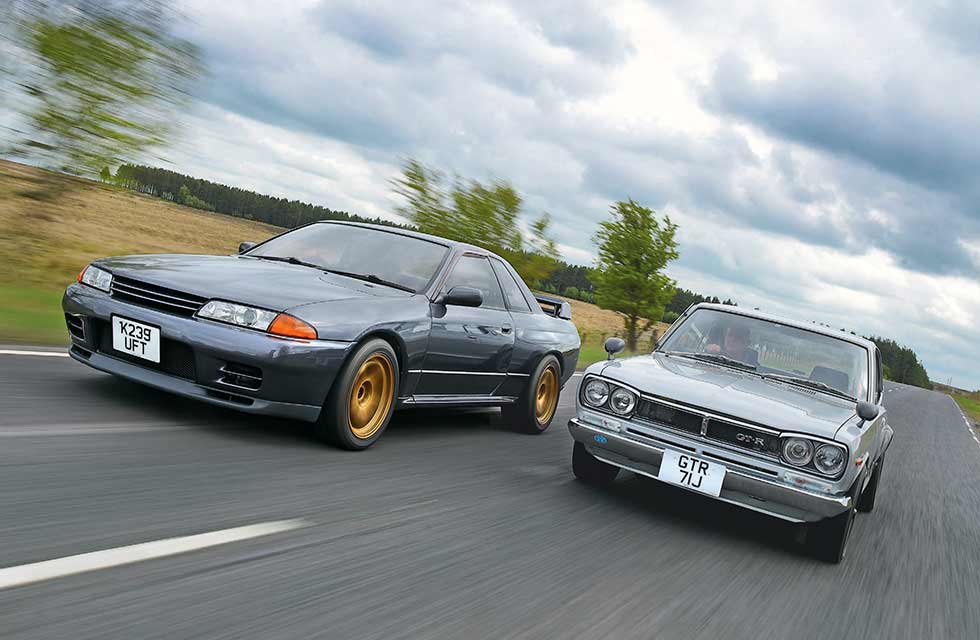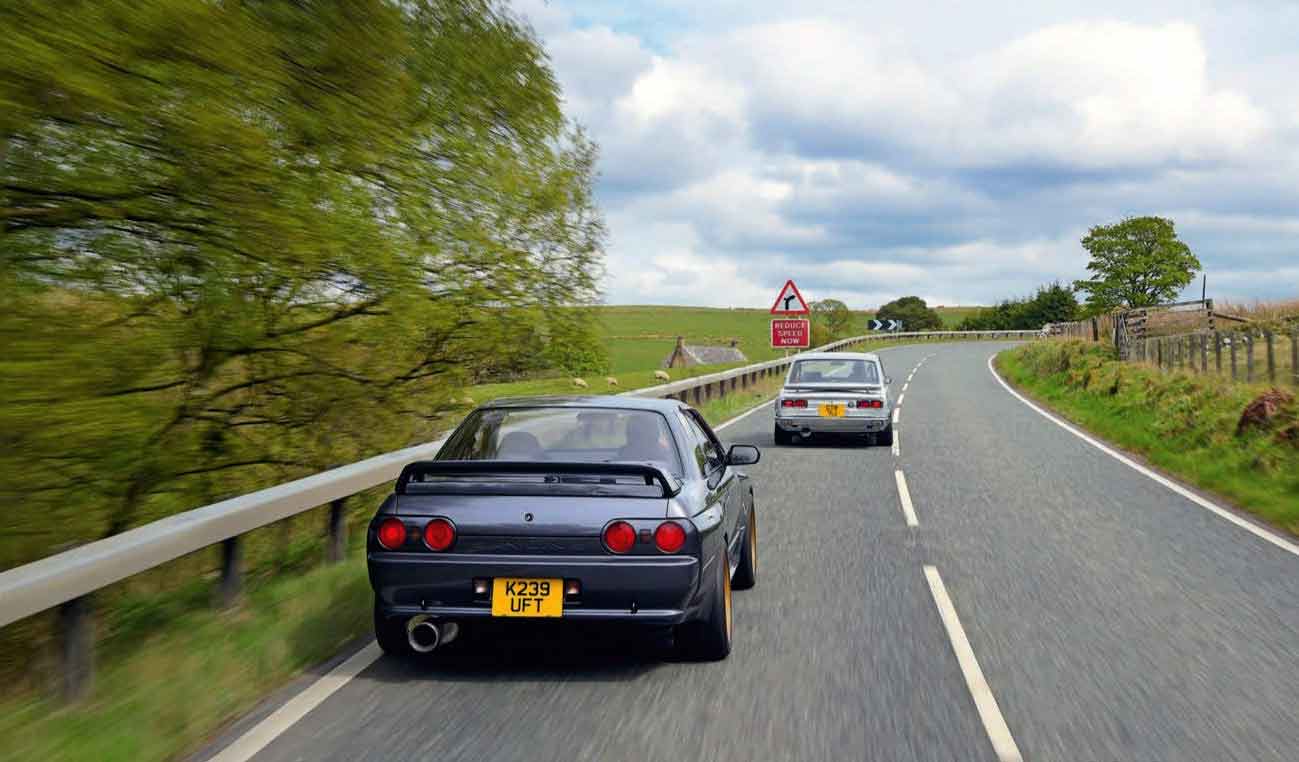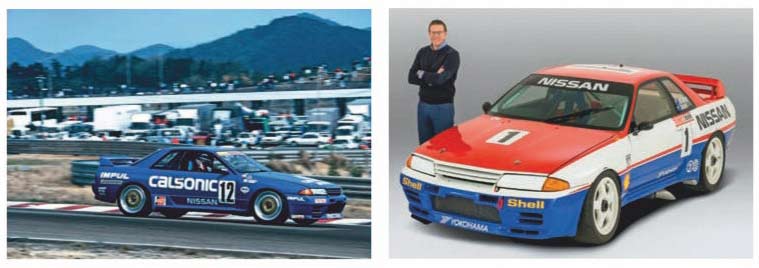
The sky’s the limit. Nissan Skyline R32 meets its 2000GT-R ancestor, as the idol of the PlayStation generation hits its 50th. Words Ben Barry. Photography Will Williams.
GRAN TURISMO MADE METAL Nissan Skyline GT-R: high-performance coupés for the PlayStation generation
NISSAN SKYLINE GT-R: FIRST & BEST ON TEST
For a performance car usually namechecked in the same breath as a games console, it’s perhaps surprising that the Nissan Skyline GT-R marks its 50th anniversary in 2019. Only 1945 of the seminal, original GT-Rs were produced, and just a handful have been privately imported into the UK, so it’s understandable if the earliest cars have made little impact beyond Japan. Known to aficionados as Hakosuka (hako meaning box in Japanese, suka shorthand for Skyline), the first GT-R does have pedigree, racking up more than 50 Japanese touring car victories in less than three years.

The BNR32 Skyline GT-R – or R32 for short – is more familiar to Westerners, and also celebrates a landmark birthday as it turns 30 in 2019.
Again no examples officially came to the UK, but a production run of 40,000-plus units, coupled with the grey-import boom of the late 1990s, means that you will occasionally see an R32 on British roads. Wheels magazine dubbed the R32 ‘Godzilla’ following the Japanese import’s controversial dominance (and later ban) in Australian Touring Cars, and a starring role in the Gran Turismo series of PlayStation games, conferred the icon status that the R32 still enjoys today – the GT-R’s futuristic technology made it a perfect fit for computer simulations.
Evocative as it is in other markets, the Skyline name is merely a mainstream nameplate in Japan, much like Sierra or Mondeo. It’s the GT-R suffix that’s key, and the story really starts with the second-generation Skyline that arrived in ’65, produced by Prince Motor Ltd. Nissan’s subsequent merger with Prince, following government pressure for the two companies to consolidate, laid foundations for the Skyline 2000GT-R. It contested a domestic touring car programme from its launch in 1969.

The attractive coupé entered production in 1970, establishing the template for every future GT-R. The saloon’s wheelbase was shortened by 70mm, 20kg came off its kerbweight, and a ‘K’ was added to the codename, for KPGC10. Both variants dominated domestic touring car racing, annihilating the factory Toyota 1600GTs before the Mazda RX-3 halted its winning streak.
Rather exotically, these first-generation GT-Rs took a detuned version of the 2-litre straight-six from Prince’s mid-engined R380 sports-prototype, which featured twin overhead cams, triple Weber carbs and four valves per cylinder. Power was rated at 158bhp through the rear wheels, helped to the ground by a limitedslip diff. Suspension was by MacPherson struts up front, semi-trailing arms at the rear.
Importer Torque GT sourced Ian Griffiths’ car from Japan a few years ago, and it’s thought to be one of only four Hakosukas in the UK. Buyers typically pay from £130,000 for a usable car requiring some TLC, up to more than £200k for a perfect, unmodified example.
At first it’s hard to reconcile the design of the early Hakosuka and the far more futuristic R32, and you’d be forgiven for guessing there was more than two decades between them. But you can see the echo down the ages: the strong horizontal lines, including the roof, which make both such usable two-plus-twos; the pillarless doors; the elongated bonnet and boot; and the beginnings of the signature quad rear lights in the Hakosuka. The older car is certainly more elegant, with a kind of déjà vu Italian style. As is common, its standard steel wheels have been switched for 15in alloys, though the bolt-on wider rear arches were factory fitted.
You sit low in bucket seats, behind a vestigial strip of dashboard angled upwards at 20º or so, its wood-grain trim leavening the black plastic and vinyl upholstery. There’s a thin three-spoke wheel and a delicate gearlever, like an unopened tulip, an easy reach away. The unassisted steering is butch at very low speeds (exacerbated by this car’s larger rubber), but it limbers up on the move, and the steering box’s much faster ratio than a standard Skyline is designed to lend a fleet-footed responsiveness to the GT-R’s handling. It’s an eagerness matched by a relatively light clutch, a gearshift that flicks across the gate with a precise little click, and supple suspension as standard (though most have since been lowered and stiffened).
The instruments are recessed down tubes like binoculars, the redline strikingly high at 7500rpm. We won’t be troubling that today, however, because the engine has only recently been rebuilt by The GT-R Heritage Centre in Durham. Boss Dave Warrener describes performance as fairly unremarkable below 3500rpm, at which point the exhaust note changes to a howl and races towards 7000rpm with real enthusiasm.
“Get a Hako on song and they still properly fly,” he grins. With the GT-R body being no different to other Skylines, it’s this extraordinary SR20 engine that accounts for the bulk of the Hakosuka’s value: tall units without ancillaries but requiring a refresh start from £50k!
There’s certainly enough performance to give the GT-R’s chassis a workout, with power winning the battle over mechanical grip. “It’s an oversteery car if you push it hard through the twisties,” confirms Warrener.
If the handling is lively, the brakes are best described as deadly, with single-piston calipers gripping discs on the front axle, drums on the rear, and a tiny master cylinder that pushes very little fluid down the brake lines. Getting slowed down nice and early on the way in, then laying into the throttle similarly early on the way out is the way to enjoy these early GT-Rs.
The even rarer KPGC110 was produced briefly in 1973 before the oil crisis snuffed it out, and other high-performance Skylines followed, albeit without the GT-R badge. But nothing could have prepared the market for the technological shock of the R32 Skyline GT-R in 1989.
More brutal than beautiful, the R32 brings to mind fighter jets with its afterburner rear lights, animated Gundam robots with its angular shape. There’s even hints of a musclebound pick-up in its silhouette, but it absolutely speaks of a country at the peak of its technological dominance. The straight-six continues the bloodline from 1969, though this time there’s a pair of parallel turbochargers – astonishingly, Nissan produced a separate twin-turbo V6 for the 1989 300ZX – plus ATTESSA E-TS all-wheel drive and Super-Hicas rear-wheel steering, the latter two mechanical systems electronically controlled. The R32 was a high-tech masterpiece, Nissan’s Porsche 959 at a time when the 911 turbo was an air-cooled, rear-drive anachronism. The racer dominated everywhere, from Spa to Bathurst.
The driver’s door closes with a baggy clang and the low-grade black plastics inside betray its mass-market saloon DNA, but there’s a likeable, no-frills air to the cockpit, which instantly feels focused around driving hard. The sports seats are low-set, gripping both torso and thighs with perfect contours and suede-effect fabric. There’s a small-diameter steering wheel (aftermarket in this car, but the standard item is a similar size), a gearlever barely a handspan away, and pedals set up by people who know how to heel-and-toe. The RB26 ‘six’ settles to a deep, sophisticated idle that’s close in spirit to period BMWs; the clutch is friendly, the hydraulic power steering fingertip-light in the car park, the tyres scrunching over the gravel as the tight rear diff binds.
The R32 is far more nuanced and mechanical in feel than its ‘digital supercar’ reputation suggests, and confidence builds quickly. The steering remains light at speed, the generous assistance complemented by a pacey ratio, but there’s also a progressive rate of response and weight as you ease through corners to clearly telegraph loading through the tyres and suspension. The steering doesn’t tug on cambers: the GT-R can be placed accurately, and feels out the surface with a delicacy that encourages you to hold it lightly, the better to decode the messages that tingle between thumb and index finger. It makes the R32 feel agile and constantly in touch with the road, reassuring you that this is no hulk to hustle should you want to push harder.
The RB26 unit was rated at 276bhp from the factory, owing to a gentlemen’s agreement between the Japanese manufacturers, though the reality is usually 320bhp or so. Like most, this car also has a few Nismo (Nissan Motorsport International) tweaks taking it up to c380bhp, which is still pretty modest given that the racers were good for 500bhp, and drag and show cars have been tuned to beyond 1000bhp.
Power delivery feels very turbocharged, if without the drawbacks you expect. Nothing dramatic occurs below 2000rpm, but a certain muscularity pervades and the straight-six purr is overlaid by a loud hiss under full acceleration as boost builds like a storm. By 4000rpm the GT-R has hit its stride but there’s no sudden kick, it’s all incredibly progressive, the linearity partially masking an indecent rate of progress.
The real surprise is how urgently it continues to pull right up to the 7500rpm redline. Change gear – with a deliciously light and precise snick – and there’s a sudden exhalation of boost pressure like the crack of a whip, then the next ratio lands you smack in the action at 5000rpm. It feels wrong not to revel in the visceral urge of it all, squeezing the slightly squishy-feeling accelerator back to the floor.
All-wheel drive ensures that the chassis isn’t overwhelmed, but far from dulls the R32’s edge. It turns in keenly, feels adjustable off-throttle (and therefore completely crashable, no matter what legend suggests), and corners with a resolutely rear-wheel-drive stance as you feel for grip under power. The GT-R is, in fact, designed to be 100% rear-drive whenever possible. Push harder and torque bolts for the front axle as if someone’s flicked a switch, the electronically controlled torque split reacting quickly to send as much as 50% forwards. The limits of traction are far higher than first impressions suggest, but it’s always with a hint of oversteer in the Skyline, rather than the understeer of an Audi quattro.
In this recently restored example, those limits are even higher courtesy of 17in Nismo alloys (an inch larger than standard) and huge Brembo brakes taken from the later R33 GT-R that give a keen pedal feel and robust stopping power. It’s a potent combination, one that still feels quick and capable today, never mind 30 years ago. No wonder values are on the up. Warrener reports that R32s could be had for £6-8000 only a couple of years ago, but today even a car in need of restoration will only just dip below £20k, and those in the mid-to-high 20s bracket typically still need light work. You’ll pay £60-£100k for the most desirable Nismo versions.
Five decades since the birth of the GT-R, it seems that Nissan’s high-performance spaceship has finally come of age.
Thanks to The GT-R Heritage Centre (www.thegtrheritagecentre.com) and Torque GT (www.torque-gt.co.uk)
NISSAN SKYLINE 2000GT-R
Sold/no built 1970-’1972/1197 (coupés only)
Construction steel monocoque
Engine iron-block, alloy-head, dohc 1989cc straight-six, triple Weber carburettors
Max power 158bhp @ 7000rpm
Max torque 130lb ft @ 5600rpm
Suspension independent, at front by MacPherson struts rear semi-trailing arms, coil springs, telescopic dampers
Steering recirculating ball
Brakes discs front, drums rear
Length 14ft 2in (4330mm)
Width 5ft 4 ½ in (1665mm)
Height 4ft 5in (1370mm)
Wheelbase 8ft 4 ¼ in (2570mm)
Weight 2425lb (1100kg)
0-60mph 8.1 secs
Top speed 124mph
Mpg 24.3
Price new not sold in the UK
Price now from £130,000

‘There’s certainly enough pace to give the GT-R’s chassis a workout, with power winning the battle over mechanical grip’
NISSAN SKYLINE R32 GT-R
Sold/no built 1989-’1994/43,937
Construction steel monocoque
Engine iron-block, alloy-head, dohc 2568cc straight-six with fuel injection and twin parallel turbochargers
Max power 276bhp @ 6800rpm
Max torque 260lb ft @ 4400rpm
Suspension independent, by multiple links, coil springs, telescopic dampers
Steering rack and pinion
Brakes discs, with servo and anti-lock
Length 14ft 9in (4545mm)
Width 5ft 7 ½ in (1755mm)
Height 4ft 4in (1340mm)
Wheelbase 8ft 6in (2615mm)
Weight 3153lb (1430kg)
0-60mph 5.4 secs
Top speed 156mph
Mpg 19.8
Price new not sold in the UK
Price now from £19,000

‘Change gear and there’s a sudden exhalation of boost pressure, then the next ratio lands you smack in the action at 5000rpm’
WINS, REGS AND “A PACK OF ARSEHOLES”
The first Skyline 2000GT-R dominated Japanese saloon-car racing, and the 1989 R32 Skyline GT-R followed suit, with 29 wins from 29 starts over three years in domestic Group A competition. But the R32’s reputation went global thanks to controversial dominance in the Australian Touring Car Championship against the likes of the Ford Sierra Cosworth RS500 and BMW M3.
Key to its success was Gibson Motorsport team boss Fred Gibson and drivers Mark Skaife and Jim Richards. A 1967 Bathurst 1000 winner with Ford, Gibson had raced and developed the Nissan Bluebird. He bought the team when the Bluebird was replaced by the Skyline DR30, itself succeeded by the HR31 Skyline in the late ’80s. Gibson brutally describes the first R32 GT-R he encountered as “a heavy, typical Japanese halfcocked racing car” and decided to take matters into his own hands: “Nismo was charging $12k for a water pump and $50k for a ’box that’d blow the side out of itself after two races. Early on I said ‘this is bullshit, we’ll do it how we want to do it’.”
Nissan attended the first test, at a rain-soaked Winton: “The GT-R would bog on the line, but ours didn’t and they’d say, ‘What four-wheel drive are you running, Fred-san?’ I explained we’d start in rear-wheel drive, then switch to four-wheel drive when the tyres started to go off. The Japanese couldn’t believe it, but they thought it was pretty good: we were paying to develop their car. They had 550bhp at Nismo, we had 650bhp.”
Upcoming hotshoe Mark Skaife drove the R32 GT-R on its debut at Mallala, round six of the eight-race 1990 calendar. “I was nominated to drive the GT-R because reliability was still questionable and Jim was fighting for the title,” remembers Skaife. That decision paid dividends when Richards won the race in the HR31, with Skaife retiring after leading when the R32’s front hub failed.
Development brought reliability to match the GT-R’s raw pace. “When we’d finished, it was the best touring car in theworld,” says Skaife. “We built our own turbos, our own front uprights, designed our own gearbox with Hollinger, tuned the four-by-four. There was hardly anything we didn’t touch.”
The R32 GT-R properly got into its stride in 1991, with Skaife following Richards home to take first and second overall after each driver finished off the podium just once all year. The CAMS (Confederation of Australian Motorsport) restricted turbo boost and added 100kg, but the Skylines again came first and second in 1992, this time with Skaife crowned champion.
Most controversial was Bathurst in 1992, when Richards crashed in heavy rain. “We radioed Richo to come in for wets, but he hit the fence before he could,” recalls Gibson. “He got back on track but then he’s on the radio again: ‘I’ve touched the wall.’ I said, ‘Mate, the car’s rooted. Bring it back slowly’.” Richards crashed again and the race was redflagged, with the final result based on positions before cars crashed en masse. The GT-R was the clear winner, but Skaife and Richards were booed on the podium. “I can’t believe this reception,” said Richards over the loudspeaker. “I thought Australian race fans had a lot more to go than this… I’ll keep racing, but this is going to stay with me for a long time. You’re a pack of arseholes.”
“CAMS, Dick Johnson and [Holden team owner] Larry Perkins got together with [race broadcaster] Channel 7 to ban the GT-R,” says Skaife. The battle went to court, but the R32 was banned from Aussie touring cars from the end of 1992. But, if anything, outlawing the GT-R only enhanced its reputation.







